#change branch git
Explore tagged Tumblr posts
Text
How to Change Branch in Git — A Quick Guide
When working with Git, managing branches is an essential part of collaborative and organized development. If you’re wondering how to change branch Git, you’re not alone. Whether you’re switching to an existing branch or creating a new one, understanding this process can make your version control workflow smoother and more efficient.

0 notes
Text
How to Change Branch in Git – Simple Guide
Learn how to change branch in Git with step-by-step instructions at Vultr. Whether switching to an existing branch or creating a new one, this guide simplifies the process. Perfect for beginners and developers managing multiple branches. Visit Vultr for complete Git command insights.
1 note
·
View note
Text


CW: soap x reader, brief mentions of past bullying, religious soap, pushy soap - dividers @/cafekitsune
The mortifying case of Soap having been one of your childhood bullies.
You spot him for the first time in years when he tugs open the door to the corner store just down the street from your parent's house—blissfully unaware of your presence as you duck away behind an aisle in hopes he won't spot you.
Despite being years older, its impossible not to recognize his face.
Last time you checked he had fucked off into the military. Why was he back in town at the same time you were? He never had been before.
Grabbing the last thing your mom needed, you wait until he's preoccupied at the fridge to sneak over to the till, ignoring the odd look from the cashier—of course John's grabbing the same old drink he used to make you steal for him. You can still remember the taunting bark of his laughter when you would sniffle and sob after delivering the beverage, absolutely sure you were going to spend the night in a jail cell if they caught you.
Bastard.
Placing the change on the counter you nod and hastily take your leave, about ready to cry tears of joy once you've made it out the shop door.
It's hard to believe he still has that much of a grip on your psyche all these years later.
Heavy breath billows from your lips as you take the crumbling road back to your parent's place, plastic bag smacking against your hip with each step—always the errand runner around here.
Even if the entire world shifted on its axis, you'd still wager that this town would manage to stay as is.
Three more days until you could go home—your real home; the spot on earth you had carved out for yourself, miles away from this unfathomably deep pit. Your scratchy childhood sheets give you a new found sense of appreciation for the set you had bought for yourself shortly after moving out; soft and well-loved atop your real bed, awaiting your return.
A large hand clamps down on your shoulder.
"Christ! Almost missed ye!" John coughs out, panting from his mad dash to catch up to you.
"Me?" you sputter out, spinning towards the towering man as you calm your racing heart.
The new angle gives you a clear look at the angry scar healing on the side of his head.
He beams, pupils a little out of sorts as he drags you in under a thick bicep. His scent is distinctly more man than you recall and his arms remind you of the sturdy branches belonging to a tree; limbs bigger than the ones you remember reaching for you when he used to chase you around the woods—you had thought them impossibly large then... what were they feeding him in the military?
"O'course! Who else but ye? That f'yer Mum?" he asks, grabbing your bag and taking a brief, distracted peek.
You don't get a chance to reply as switches his attention, nudging his nose into the top of your head to practically inhale your hair. he rumbles happily. "Thought I'd ne'er see ye' again."
you forcefully dig your heels into the gravel and wiggle out of his grip.
"Why would you want to see me? Don't you hate me?" you spit, frowning as you snatch your bag back.
You watch confusion eat away at him for a second before his thin lips press into a frown that mirrors your own, dark lashes trembling a bit as he glares a hole through you.
"Hate ye? Ye think ah hate ye?"
You weren't going to do this—not with the boy that had gleefully isolated you from everyone in your age range during the most important social years of your early life.
"Yer daft!" he suddenly laughs, slipping back into his jovial grin. "-Gave me a fright there for a second!" he pulls you back into him with embarrassing ease and begins to walk again, knuckles grinding into your head before he grabs the bag from you, a satisfied chuckle leaving his lips. "Cannae believe ye thought ah hated ye—Had the biggest crush oan ye,"
No.
"-Thought ah was makin' it obvious!"
No—not this.
"Ah was a jealous wee git, detested ye hangin' out with yer pals. Likely made a right fool o'maself." he rubs at your arm with his large, bear-like palm and sighs contentedly. "No matter, Ah'm no a teenager anymore. How long ye in town for?"
you tug your gaze away from the tight-fitting grey hoodie straining pathetically over his muscles, letting it land on your shoes. he notices your reluctance and laughs, giving you a squeeze
"-God gave me a second chance, ahm no lettin' ye slip away���Full steam oan till we’re wed this time, alright?"
2K notes
·
View notes
Text

Welcome back, coding enthusiasts! Today we'll talk about Git & Github , the must-know duo for any modern developer. Whether you're just starting out or need a refresher, this guide will walk you through everything from setup to intermediate-level use. Let’s jump in!
What is Git?
Git is a version control system. It helps you as a developer:
Track changes in your codebase, so if anything breaks, you can go back to a previous version. (Trust me, this happens more often than you’d think!)
Collaborate with others : whether you're working on a team project or contributing to an open-source repo, Git helps manage multiple versions of a project.
In short, Git allows you to work smarter, not harder. Developers who aren't familiar with the basics of Git? Let’s just say they’re missing a key tool in their toolkit.
What is Github ?
GitHub is a web-based platform that uses Git for version control and collaboration. It provides an interface to manage your repositories, track bugs, request new features, and much more. Think of it as a place where your Git repositories live, and where real teamwork happens. You can collaborate, share your code, and contribute to other projects, all while keeping everything well-organized.
Git & Github : not the same thing !
Git is the tool you use to create repositories and manage code on your local machine while GitHub is the platform where you host those repositories and collaborate with others. You can also host Git repositories on other platforms like GitLab and BitBucket, but GitHub is the most popular.
Installing Git (Windows, Linux, and macOS Users)
You can go ahead and download Git for your platform from (git-scm.com)
Using Git
You can use Git either through the command line (Terminal) or through a GUI. However, as a developer, it’s highly recommended to learn the terminal approach. Why? Because it’s more efficient, and understanding the commands will give you a better grasp of how Git works under the hood.
GitWorkflow
Git operates in several key areas:
Working directory (on your local machine)
Staging area (where changes are prepared to be committed)
Local repository (stored in the hidden .git directory in your project)
Remote repository (the version of the project stored on GitHub or other hosting platforms)
Let’s look at the basic commands that move code between these areas:
git init: Initializes a Git repository in your project directory, creating the .git folder.
git add: Adds your files to the staging area, where they’re prepared for committing.
git commit: Commits your staged files to your local repository.
git log: Shows the history of commits.
git push: Pushes your changes to the remote repository (like GitHub).
git pull: Pulls changes from the remote repository into your working directory.
git clone: Clones a remote repository to your local machine, maintaining the connection to the remote repo.
Branching and merging
When working in a team, it’s important to never mess up the main branch (often called master or main). This is the core of your project, and it's essential to keep it stable.
To do this, we branch out for new features or bug fixes. This way, you can make changes without affecting the main project until you’re ready to merge. Only merge your work back into the main branch once you're confident that it’s ready to go.
Getting Started: From Installation to Intermediate
Now, let’s go step-by-step through the process of using Git and GitHub from installation to pushing your first project.
Configuring Git
After installing Git, you’ll need to tell Git your name and email. This helps Git keep track of who made each change. To do this, run:

Master vs. Main Branch
By default, Git used to name the default branch master, but GitHub switched it to main for inclusivity reasons. To avoid confusion, check your default branch:

Pushing Changes to GitHub
Let’s go through an example of pushing your changes to GitHub.
First, initialize Git in your project directory:

Then to get the ‘untracked files’ , the files that we haven’t added yet to our staging area , we run the command

Now that you’ve guessed it we’re gonna run the git add command , you can add your files individually by running git add name or all at once like I did here

And finally it's time to commit our file to the local repository

Now, create a new repository on GitHub (it’s easy , just follow these instructions along with me)
Assuming you already created your github account you’ll go to this link and change username by your actual username : https://github.com/username?tab=repositories , then follow these instructions :


You can add a name and choose wether you repo can be public or private for now and forget about everything else for now.

Once your repository created on github , you’ll get this :

As you might’ve noticed, we’ve already run all these commands , all what’s left for us to do is to push our files from our local repository to our remote repository , so let’s go ahead and do that

And just like this we have successfully pushed our files to the remote repository
Here, you can see the default branch main, the total number of branches, your latest commit message along with how long ago it was made, and the number of commits you've made on that branch.

Now what is a Readme file ?
A README file is a markdown file where you can add any relevant information about your code or the specific functionality in a particular branch—since each branch can have its own README.
It also serves as a guide for anyone who clones your repository, showing them exactly how to use it.
You can add a README from this button:

Or, you can create it using a command and push it manually:

But for the sake of demonstrating how to pull content from a remote repository, we’re going with the first option:

Once that’s done, it gets added to the repository just like any other file—with a commit message and timestamp.
However, the README file isn’t on my local machine yet, so I’ll run the git pull command:

Now everything is up to date. And this is just the tiniest example of how you can pull content from your remote repository.
What is .gitignore file ?
Sometimes, you don’t want to push everything to GitHub—especially sensitive files like environment variables or API keys. These shouldn’t be shared publicly. In fact, GitHub might even send you a warning email if you do:

To avoid this, you should create a .gitignore file, like this:

Any file listed in .gitignore will not be pushed to GitHub. So you’re all set!
Cloning
When you want to copy a GitHub repository to your local machine (aka "clone" it), you have two main options:
Clone using HTTPS: This is the most straightforward method. You just copy the HTTPS link from GitHub and run:

It's simple, doesn’t require extra setup, and works well for most users. But each time you push or pull, GitHub may ask for your username and password (or personal access token if you've enabled 2FA).
But if you wanna clone using ssh , you’ll need to know a bit more about ssh keys , so let’s talk about that.
Clone using SSH (Secure Shell): This method uses SSH keys for authentication. Once set up, it’s more secure and doesn't prompt you for credentials every time. Here's how it works:
So what is an SSH key, actually?
Think of SSH keys as a digital handshake between your computer and GitHub.
Your computer generates a key pair:
A private key (stored safely on your machine)
A public key (shared with GitHub)
When you try to access GitHub via SSH, GitHub checks if the public key you've registered matches the private key on your machine.
If they match, you're in — no password prompts needed.
Steps to set up SSH with GitHub:
Generate your SSH key:

2. Start the SSH agent and add your key:

3. Copy your public key:

Then copy the output to your clipboard.
Add it to your GitHub account:
Go to GitHub → Settings → SSH and GPG keys
Click New SSH key
Paste your public key and save.
5. Now you'll be able to clone using SSH like this:

From now on, any interaction with GitHub over SSH will just work — no password typing, just smooth encrypted magic.
And there you have it ! Until next time — happy coding, and may your merges always be conflict-free! ✨👩💻👨💻
#code#codeblr#css#html#javascript#java development company#python#studyblr#progblr#programming#comp sci#web design#web developers#web development#website design#webdev#website#tech#html css#learn to code#github
93 notes
·
View notes
Text
So I came across this recently.
It's funny, because I think I exactly half agree with it. I do rebase-heavy workflows in Git mostly because every single Git client makes merge-based workflows ugly and hard to use. If GitHub simply displayed merges the way it displayed squash-merges, that would eliminate so much of the need for squash-merges.
But I don't think this covers everything. So let me go through every use-case for rebase separately:
git merge --squash
The squash-merge is one of the most popular ways to merge pull requests on GitHub, and it's an abject failure of the Git ecosystem that it's so popular.
When you do a regular merge on a pull request, you are essentially taking a bundle of commits from somewhere else, and putting it on top of your own main branch. It's an extremely linear thing to do.
But if you do that, GitHub's commit log just gets a bunch of commits interspersed throughout, with zero indication where they're from. And the nicer clients, if they do, visualize it as a tree (pronounced "DAG") (pronounced "a huge tangle of curvy lines"):

This pic is from an article telling you to rebase, and, like, sure, rebasing sure is one way to work around a UI that displays your merges as a huge tangle. But Fossil makes a really good point. Why not instead display your merges as, like, not a huge tangle? git log --first-parent does this (and that's clearly an option in that Git UI), but it should be the default everywhere. And even when expanding the "bundle", the bundled commits should still be grouped together, not interspersed with other commits at essentially random.
The other issue is that, when showing the "tangle of commits", the reason it's so tangled is because it's showing the commits in chronological order of when the commits were made. Which is a completely useless sort order, compared to, say, chronological order of when they arrived in the current branch (i.e. grouping the merged-in commits together). This is why GitHub's rebase-merge is also such a popular alternative to merges.
git pull --rebase
Okay, so. Now you've fixed commit log visualization of merged pull requests. But that's not the only use of rebase! Here's another one: if you're working on some code, and constantly keeping it synced with remote, you'll generate tons of merges that are complete useless noise. Unlike a merged PR, these should ideally be hidden completely, or at least nearly-completely.
Anti-rebase people say that these merges serve the functionality of, like, preserving history. You made one commit when the remote was in this state, and another commit when the remote was in that state, and this is sometimes important history to preserve.
I think they are way overestimating how important that history is (judging by how many people use pull-rebase). I'm fine preserving that history if you can declutter the UIs, but it does require your UI to be able to distinguish between "important" merges (of new features from feature branches) and "unimportant" merges (keeping branches in sync with remotes).
The linked post doesn't talk about this problem at all, so I don't know how well Fossil handles this.
git commit --fixup
That leaves the amend/fixup commit. The link does mention that Fossil supports editing past metadata (e.g. commit message). But sometimes you want to edit the actual changes of a commit.
Now, for a sufficiently published commit, this is a bad idea. But if you have a habit of "commit early, commit often", having 50 bugfix commits makes a commit log really cluttered.
I frequently, like, have to weigh stuff like "is it worth cluttering the commit log to fix one typo in one comment?" for old code. And it would really suck to also have to do that for unpublished code, instead of going in with my trusty rebase scalpel.
git that's all I wanted to say
In conclusion. git rebase is a solution to a number of things that could also be viewed as UI problems, and fixed in other, better ways, and Fossil sure sounds like it's fixed some of them. But some of those UI problems are legitimately hard, and I'm not convinced Fossil fixes all of them, and GitHub extremely has not, so I'm gonna keep rebasing.
41 notes
·
View notes
Text
git loves to be like
$ git status On branch main Your branch is up to date with 'origin/main'. $ git pull [...] 347 files changed, 98237 insertions(+), 53968 deletions(-)
116 notes
·
View notes
Note
Please tell me something about "For the dead travel fast" because I am guessing this is a WIP I will like very much 😬
Hello friend! I talked a little bit about it here, and I hope you will like it as it contains your favourite couple AND we even have Fabian (because why wouldn't I throw him in). But this is as good a chance as any to test whether I have captured the complicated mess that is Wolfstar.
'So,' said Sirius casually as Remus closed the door behind him, 'how's James?'
Remus stilled.
'James?'
Taking a deep breath, he turned to face his boyfriend.
'Scrawny git, messy hair, wears glasses.'
Sirius' tone was not nearly as light as his words: each syllable laced with impatience.
'What makes you think I've seen James?'
'Come off it,' Sirius snapped, all pretence vanishing. 'Jim crashes the car so that I am stuck here being miserable, and twenty hours or so later, he's still not been here to apologise?'
No, Sirius, I haven't been to see James... because, you see, nobody has seen him. Or Lily.
Remus couldn't get the words out.
'He's hurt.'
It came from Sirius, low and certain, as he studied Remus intently.
Remus shivered. The look in Sirius’ eyes was familiar, and yet completely foreign. Cold. Calculated. Dangerous. It was the expression he usually reserved for enemies.
We don't know.
Panic clawed its way through Remus as reality forced itself upon him. They had no idea if James or Lily were injured. The thought of admitting as much to anyone, let alone Sirius, was terrifying. It would make everything real, in a way nothing else—not even the abandoned car—had.
'He got out after the crash... I don't know if you remember,' said Remus, carefully. Not because he meant to keep anything from Sirius, but because he still couldn’t find the right words.
'That's not the same thing, which you know.'
Sirius had studied ancient Greek and Latin. He was fluent in words and nuances. Remus' omissions were child's play to him.
Remus let out a breath he did not know he'd been holding. The moment of truth, then-:
'We don’t know.'
The words tasted wrong even as he said them. There was no good way of telling Sirius this. No gentle version of James is missing. No way to cushion the blow. No reassurance to offer. If there had been, Remus would have clung to them already.
'What do you mean?' Sirius’ brow furrowed.
Whatever he’d expected, it wasn’t this.
Of course not. No one ever imagines their best friend will vanish. No one thinks this will happen to them. Whatever this was. Abduction? Another accident?
Murder? A question that slithered in, uninvited.
'Nobody has seen James—or Lily—since they stayed behind with the wrecked car.'
'When you say "nobody" -' Sirius started.
'I mean—nothing, Sirius,' Remus exhaled, exhaustion settling into his bones like frost.
They were standing at a divide between two lives: the one they had lived, and a new one. Whatever came next, Remus had the horrible sensation that things would never be the same.
'They've not been in touch... We've been driving up to the scene of the accident: The car is still there, but...'
Remus' voice trailed off.
'So they're just gone? Disappeared into thin air?'
Remus didn't answer.
Sirius sat up: 'People don't just evaporate, Remus. So what do you and the others think happened? What lines are we investigating?'
Remus swallowed. Sirius really wasn't going to like the next bit either.
'I think you should sit down.'
The change in Sirius’ tone caught Remus by surprise.
'Sorry?'
'Sit, Remus.'
Despite everything, Remus could hear the affection in Sirius' voice. It was his olive branch.
Remus sank down, though he chose the sofa, rather than the edge of the bed. He wasn't sure he could be a good partner right now. The space helped keep things clinical, somehow.
'Gideon reckons there is a chance that James was more injured than he let on—or was able to notice,' said Remus. 'Alice is checking the nearby hospitals.'
'I can believe the "able to notice" part,' Sirius agreed, looking thoughtful. 'That's happened before. But James... Not letting on being injured...'
The comment was no doubt intended to lighten the mood a little, but it was Remus' turn to frown: 'I know what you're thinking, but there are two circumstances in which he would keep quiet. Both of which were present.'
'Evans, of course.' Sirius shook his head; then grimaced. Probably not the best thing to do with a concussion, Remus thought. But there was no point in saying anything.
So much for "taking it easy" and "no strenuous" activities.
'Precisely,' agreed Remus.
'And...' Sirius started.
He closed his eyes for a second as realisation must have dawned.
'And us.'
'And us,' repeated Remus, his throat feeling tight, the memory of their disastrous Duke of Edinburgh expedition floating to the surface.
James would keep quiet if he was worried about their well-being. Which he would have been.
'Okay, well,' said Sirius. 'That tracks.'
Except it didn't track. Sirius must have known that as well as Remus did. Why hadn't Lily contacted them, if James was in hospital?
'Any idea when Alice might know more?'
As it turned out, exactly at that moment.
There was a knock on the door.
'He knows,' said Remus, as he opened it and Alice, Fabian, and Gideon stepped inside.
None of them sat.
Alice was trembling, even if only slightly. Remus had never seen her like this. Neither Fabian nor Gideon put a reassuring hand on her arm—and somehow, that was worse. Whatever they’d found out, it wasn’t good.
None of them met Remus’ eyes.
‘Either James is more injured than you feared,’ said Sirius, his voice deadly calm, ‘or we still have no idea where James and Ev-Lily are.’
Everyone in the room knew Sirius well enough not to be fooled by his tone. This was Sirius at his most lethal. This was Sirius being scared.
There was, of course, a third option for why the three would be acting this way, but not one that Sirius, or Remus, would acknowledge.
Alice shook her head: 'Nothing. Wherever they are, they're not at a hospital.'
There was more.
#james potter#sirius black#remus lupin#lily evans#fabian prewett#gideon prewett#alice longbottom#jily#wolfstar#marauders fic#Dracula inspired AU#WIP
22 notes
·
View notes
Text
what do you see in her?!
luke castellan x artemis!daughter!reader

start to a series
part 1, part 2, part 3
summary; luke stands up for you
series masterlist

when he first arrived at camp he was a bit scared of you. your stern gaze and biting words, he wondered if you ever laughed.
then during archery he saw you shoot an arrow right into another, that’s when he knew he had to be your friend.
after that, it was as if you couldn’t shake him, he followed you during trainings, sat with you at lunch and campfires, he even begged mr. d to put hermes and artemis cabins together for capture the flag.
when you finally got used to the annoying git, you realized how fun he was to be around. you guys would pick fruits, swim, and make crafts together, he swears he even saw you smile a couple of times.
then when you guys were older and more mature - you more than him - he developed a sort of crush on you. he would hold your hand on walks, comfort you during hard times, and patch you up after rough trainings.
over time you guys grew incredibly close, and you might have even fallen for him too.
you enjoyed the way he made you laugh and smile, the way he would blush slightly when anyone mentioned you two as really close, but you found yourself most drawn to how good of a friend he was to everyone. never leaving out the younger kids or the kids who had trouble making friends. he was sweet to everyone, which is why you found it weird he was so close with you.
you didn’t have many friends and most people ignored you in fear, people constantly asked you why you were mad when you weren’t - cure that resting bitch face -, and most people gave weird looks when you and luke were together.
i mean, how could someone so gentle and kind be friends with someone so cruel and angry. it was if he pitied you for being so weird to other people.
you constantly doubted that he actually liked you, that he actually enjoyed spending time with you.
that was until you overheard him talking with someone.
you were up in a tree, reading your favorite book to escape everyones loud chatter and laughter.
you were meant to meet luke in about an hour to go to the lake so you took the time you had to yourself with an open mind.
all the sudden you hear your name causing you to look down. through the bushy leaves and overgrown branches, you could make out luke and some demeter boy that you briefly recognized as he was quite popular standing and talking.
“i mean, why are you even friends with her, she’s weird. everyone hates her and she doesn’t even try to change our minds.” the demeter boy spoke.
“don’t say that about her. she- she’s not- look man, just because you guys don’t try to actually get to know her and just assume who she is, doesn’t mean that you have to belittle her. it’s not her fault she looks mean, she’s not, she’s actually quite funny and caring. you’re just mad because you can’t win over one person, and she’s better than you could ever be.” luke speaks passively and shoulder checks the boy before stomping off in anger.
it was then that you knew, you had fallen completely in love with luke castellan.
124 notes
·
View notes
Text
On Keeping Good Habits
I, like everyone else with any productive hobby, have more ideas and things I want to try than time and skill to implement them. I'll start on developing something and then either life or that next great idea comes by, then suddenly whatever I was working on is lost to time, usually in some sad partially-implemented state.
For projects like mine, modern source control is a godsend. New idea? Create a branch. If it works out, merge. If it gets abandoned, forever stare wistfully at the branch that went nowhere that can't be deleted because surely inspiration & inclination will one day lead back to it (it won't).
Of course for that to work one has to ... use ... source control.
I have a GitHub account. I have repositories for my projects. I even have some branches for developing new ideas.
My recent multi-user BASIC kernel was developed on a working branch on the repository for that particular homebrew project. And I branched off that to add a supervisor console to the kernel.
And when I got it working I ... went straight into developing a new idea without so much as committing the working version to the development branch.
Once I got the machine running again last week, I had some minor changes I wanted to make to the kernel code. Which of course is when I realized what I had done.
What followed was hours of trying to bring together the last unstable commit and the current incomplete mess. I even pulled out ghidra to disassemble the one good ROM I had to compare against. Hours of reverse-engineering my own project to figure out what I had done, instead of adding the new feature I wanted to add.
All because I hadn't kept up with my repository.
I've cleaned up the mess, and was able to get the code back to compiling byte-by-byte identically to what was on the good ROM. But that time is gone. It's not likely I'll be making the same mistake again any time soon.
Sometimes good habits come from lessons hard learned.
(and the real hell of it is — I use git for my paying job every day and would never make such a mistake there...)
15 notes
·
View notes
Text
[me talking to git like a midwife]
you're doing great! now push! PUSH! that's it, you're almost there! don't stop, I can see the HEAD! that's it, you did it!!
8 commits, 12 changes. a healthy baby branch! it's a miracle to witness every time
21 notes
·
View notes
Text
Brozone & Acquaintances: Fame and Blunders (The Rise And Fall, The Epic Highs And Lows Of Trolltwt) Part Six
split into a new post bc the last one (parts 1-5, crossposted on ao3 (including intermission)) got too long. as always, cowritten by the evil genius @squirrelpatties
cloud guy: infamous leaktwt contributor, with a specific fixation on branch (and to a lesser extent anyone close to branch, but branch is his #1). he got his hands on several embarrassing baby photos of branch, which even jd was concerned about, because "we never published those ones, they were just for grandmas wallet". some of his most well known leaks were "barb was admitted to rehab" "creek got a BBL" and "smidge had a miscarriage" (the latter overshadowing the other two by a significant margin)
sky toronto: egotistical millionaire who bought twitter and changed the logo into a tie. whenever creek posts a new off-the-wall conspiracy theory to his impressionable audience, sky replies that hes "Looking into this..." (theyre oomfs). many of his experimental party supplies have killed a disgusting amount of animal test subjects but that doesnt mean hes not willing to test on trolls. branch almost dies when hes hit by someones neuro-mind-link party popper.
smidge vs barbtwt: several influential barbtwt members with a tie to a certain infamous leaker who shall not be named (they paid him. he didnt need the money he just likes messing with people) get their hands on smidges medical records, initially to prove shes trans (shes not) but they instead learn about her miscarriage. instead of backing off, showing her sympathy and feeling guilty about this disgusting breach of privacy, they coordinate to make this public knowledge the next time smidges name trends. twitter is divided into "smidgetwt supporting her wholeheartedly through this horrible situation" "smidge antis who think 'she had it coming'" and "barbtwt happy that smidge is suffering". this sparks a debate on the ethics of trolls smoking while with eggs, with pro-egg-smokers saying its their body their choice and anti-egg-smokers saying "are you out of your damn mind". this is how smidge reveals she is simultaneously pro-egg-smoking and pro-life. its a bloodbath. she drops off the face of the internet never to be seen again........ unless 🤔
cloud guy (part 2): after years of providing the public service of "making branchs life miserable", cloud guys twitter account (and IP) is sadly permabanned when poppy demands sky toronto take action the third time branch is doxxed. sky toronto originally didnt care but after a solid week of her pestering him, he gave up, but only because he forgot to take "no doxxing" out of troll twitters TOS, and the backlash would be worse than hes willing to deal with right now. sleep well, soldier 🫡.
dante vs poppy: dante is branchs stalker. routinely stakes out by branchs pod to take photos of him for his shrine. its not a sex thing but whatever it is is way weirder than a sex thing. branch has moved pods 3 times but dante always manages to find him. perhaps he has friends in high places? regardless of the "how", the "what" is poppy wants him fucking Gonezo. unfortunately dante, as an ambassador for classical trolls, is not under poppys jurisdiction of pop trolls. she decides the only way to deal with the "rando stalking my partner" situation is to catch him with one of branchs traps. except, dante can fly, so rope traps arent effective and poppy needs to get creative and potentially very violent. she asks branch if he still has those spikes she begged him to take down. he does but he repurposed them as hat racks. now he needs to find somewhere else to put his hats!
gus tumbleweed: lowtiergod-esque fighting game streamer whos known for yelling and screaming at his opponents when he loses. he goes into long, drawn out, nonsensical similes and metaphors to describe how much he wants the player who beat him to kill themself or otherwise die painfully
tiny (in game chat): git rekt f4gg0t gus (on mic): someone outta hog tie ya and hang ya up in the middle o town like a pinata caught sleezin with the mayors daughter tiny (in game chat): bro
is invited to take part in a tournament for charity during pride month. when beaten by a gay guy he regresses to violently homophobic hatespeach. youd think thisd be a career ender but its amazing what "pretending to be attracted to your fellow straight male friends" can fix! he makes a halfhearted comment about thinking one of his streamer friends is handsome and/or has a nice ass and everything is back to normal, and he faces zero consequences for his actions.
holly darlin: fellow twitch streamer, although in different circles to gus tumbleweed. she is undefeated at chess but otherwise unremarkable, yet because shes a woman everyone hates her. after a year or two or constant hate she decides "fuck it" and commits to selling snake oil. the hell are they gonna do? call her a whore? shes already got every variation and misspelling caught in autofilter, buddy. she peddles for the same company that supplies the diet pills satin and chenille hype up on their podcast. its how she and satin meet. theyre lesbians now. it makes the hate holly gets SOOOOOO much worse but satins used to it so shes unaffected. chenille gets no say in the matter
synth: third and final twitch streamer (...so far). the gay guy who beat gus in a tournament for charity and was met with violent hatespeach. beforehand was one of the smaller creators in the tournament but afterward he blew up a lot more. he does a lot of charity streams, mostly for the benefit of disabled children, out of the goodness of his heart and NOT the glory like some OTHER trolls mentioned two paragraphs previous. hes just a good guy! also almost had a thing with branch when they were both confused about each others identities.
synth: today marks a year since i almost kissed a very attractive twunk in pop village and then found out he was a lesbian who thought i was a lesbian minuet: gay culture
broppy: theyre doing great! absolutely NO problems whatsoever! im sure it will last forever!
21 notes
·
View notes
Text
A beginners guide to GIT: Part 4 - How to use GIT as 1 person
Table of content: Part 1: What is GIT? Why should I care?
Part 2: Definitions of terms and concepts
Part 3: How to learn GIT after (or instead of ) this guide.
Part 4: How to use GIT as 1 person
Part 5: How to use GIT as a group.
When it comes to not getting in each other's way, working alone is the simplest (It has a lot of other drawbacks). This is the simplest way to use GIT. You can do it with an external repository as a backup or just locally on your computer. It depends on how important your project is. If your laptop crashes tomorrow, which projects would you have a really hard time losing? Better to have an external backup for that. Github is often used for this (Maybe less now that Github makes machine learning AI’s, and so ARE stealing your code to train their AI on.) but you can also use Bitbucket (Which... may also steal your code...) and there are many many others out there. GIT is often used in certain patterns, called “workflows”. These have you working in more or less rigid ways to make it simple to work together. But since you are working alone, you do not risk others changing your code while you are working, so you can do it the simplest way :D
I will be doing a step by step guide that you can follow along. I will be doing it on a completely empty project and making a tiiiiiny program in C. This is because it is super simple. You do NOT have to know C to follow. You can also follow the steps with your own already existing project.
I PROMISE you, GIT cannot hurt you. Worst case scenario is that you fiddle around and break the repository part. (Meaning the files in the .git folder). But your files will always be safe.
(If you do not have git installed, check out part 3 for that)
First, I make a folder, navigate my shell into it, and call git init:
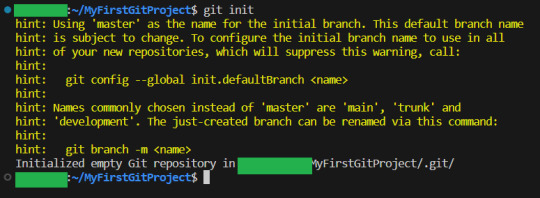
By the way, you can get used to GIT messages like this that tell you all your options, and explain what GIT has done for you. GIT is very good about giving you as much help and info as possible,
Now I will teach you the most important command in GIT.
It is more important than any other. Ready?
git status

This makes GIT tell you what git thinks is happening right now. What issues there are and what files are tracked, untracked or have been changed. Use this command often, especially while you are new to GIT, run it after every other command. It is how you learn what GIT is doing and thinking :3
Since our repo is empty it tells you what branch you are on (master. The only branch we will need since we are working alone)
and that you have not made any commits.
It also tells you the commands git think you will want to use on files. Since our repository is empty, it tells us to create some files, and then how to add them :3 So let's do that:
I have added my tiny program, as you can see:
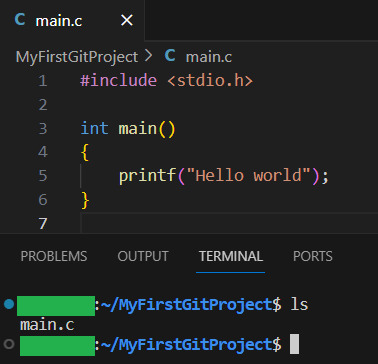
Now let us see what GIT thinks we did:
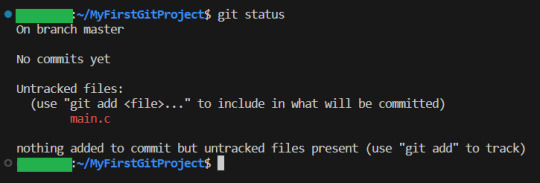
Now, since there have been changes, git shows us them.
Files can be untracked tracked and not changed (In which case, git status does not show them) tracked and changed.
Right now, main.c is untracket. Which basically means GIT have no idea about this file, other than it is in the folder.
Ok, let us commit(save) the file. GIT tells us this is done with git add <File> . So we will write git add main.c
Then we use git status again to see what happened git status
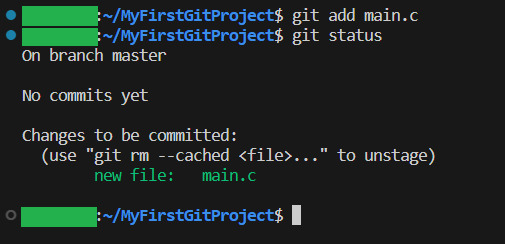
And yeah, our file is now ready to be committed. So lets do it! git commit -m “My first commit!”
The “-m” option is to write the git update explanation directly in the console instead of using an external program to do it. Done You have now committed your code! It is now saved!
git status shows that everything in the working tree is as it was last time we committed (Duh. We JUST committed)
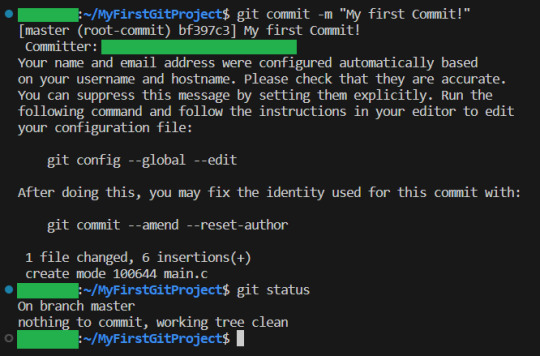
I will now make some changes to the main file:

Git status shows us main.c was changed...but what if we wanted to know what was changed in more detail? How will we get status to do that for us? Let us find out! git help status
git then shows the help page for status And there we can see this part:

So if we write status with 2 -v arguments, we get all the details. Let us try:
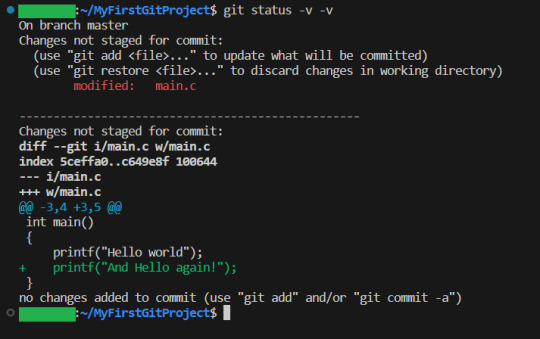
And look! It shows us EXACTLY what lines were changed! I stage the changes and commit:
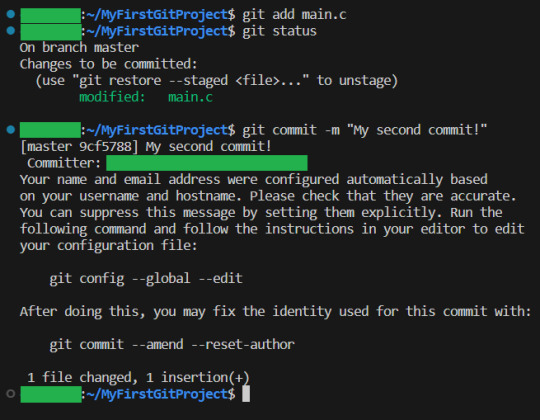
And you have now learning enough about GIT to use it.. You now have all your work saved, in different commits. If you ever want to know all the commits you have made, write git log:
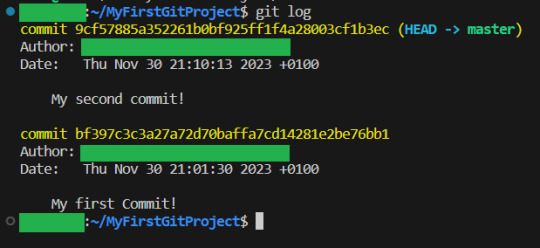
And if you want to know what a specific commit did, you copy the name of the commit, and write git show:

Now, everytime you want to save your work, you
1: Write/change the files you want
2: Add the files you want as part of this commit
3: make the commit These three steps are your workflow.
If you have a remote repository, then you add them steps
4: push to remote repository
To do this step, you can actually just write
git push
If you have set up a remote repository, then it just works. If you have not, then git will tell you what to do Whichever remote repository you use will tell you if you need to do other steps, like setting up passwords or ssh keys. They will also tell you how to set up the remote repository (That is not a GIT thing, that is a bitbucket or a github thing, so refer to whichever of those sites you want to use) And that is all! Every time you commit, your project is saved (it is smart to commit often, but usually only commit when your project can be compiled.) And whether you use a remote repository or not, you now have a fully valid GIT repository, and all the git tricks can be used on your project!
39 notes
·
View notes
Text
bah, the hack week project I was working on was supposed to happen on SourceHut which is a git-send-email based forge, but one of the other contributors wanted to move to github and I admit one does not sound reasonable asking people to do git-send-email in 2023.
I learned git independently of GitHub and web-based git in general, and even at my old job we tracked our system image with normal branch-based development, with merging and maintenance mostly handled user-side, so I really haven't ever internalized pull requests.
It's such a messy way to handle contribution! Having to generate my own fork and look after it just so I can fire off a ten line patch feels way worse than just cloning the main repo, making some changes, and running
git send-email --to="[email protected]" HEAD~
Fortunately it looks like someone handled migrating my work for me but like, now we have these three repos that all have to stay in sync and we each have a devel and master branch and gah. So many moving parts. I am very stupid, do not make me do this.
38 notes
·
View notes
Text
does anyone know how to nicely manage dark/light mode stuff in dotfiles? like, some universal way to change what config file is used?
i currently have a second branch where i have light mode configs, but tbh it's kinda bothersome. in theory i could just do git checkout and all the files get switched, but things such as my wayfire.ini are difficult to keep updated on both branches, so my main branch is behind
5 notes
·
View notes
Text
GitHub and Git Commands: From Beginner to Advanced Level
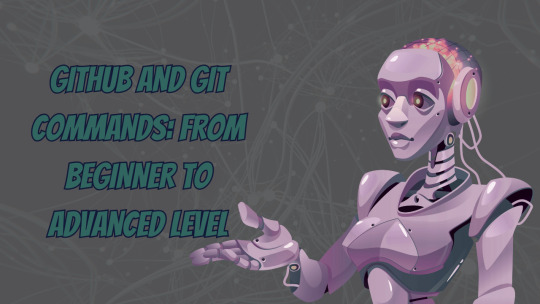
Git and GitHub are essential tools for every developer, whether you're just starting or deep into professional software development. In this blog, we'll break down what Git and GitHub are, why they matter, and walk you through the most essential commands, from beginner to advanced. This guide is tailored for learners who want to master version control and collaborate more effectively on projects.
GitHub and Git Commands
What Is Git?
Git is a distributed version control system created by Linus Torvalds. It allows you to track changes in your code, collaborate with others, and manage your project history.
What Is GitHub?
GitHub is a cloud-based platform built on Git. It allows developers to host repositories online, share code, contribute to open-source projects, and manage collaboration through pull requests, issues, and branches
Why Learn Git and GitHub?
Manage and track code changes efficiently
Collaborate with teams
Roll back to the previous versions of the code
Host and contribute to open-source projects
Improve workflow through automation and branching
Git Installation (Quick Start)
Before using Git commands, install Git from git-scm.com.
Check if Git is installed:
bash
git --version
Beginner-Level Git Commands
These commands are essential for every new user of Git:
1. git init
Initialises a new Git repository.
bash
git init
2. git clone
Clones an existing repository from GitHub.
bash
git clone https://github.com/user/repo.git
3. git status
Checks the current status of files (modified, staged, untracked).
bash
git status
4. git add
Stage changes for commit.
bash
git add filename # stage a specific file git add . # stage all changes
5. git commit
Records changes to the repository.
bash
git commit -m "Your commit message"
6. git push
Pushes changes to the remote repository.
bash
git push origin main # pushes to the main branch
7. git pull
Fetches and merges changes from the remote repository.
bash
git pull origin main
Intermediate Git Commands
Once you’re comfortable with the basics, start using these:
1. git branch
Lists, creates, or deletes branches.
bash
git branch # list branches git branch new-branch # create a new branch
2. git checkout
Switches branches or restores files.
bash
git checkout new-branch
3. git merge
Merges a branch into the current one.
bash
git merge feature-branch
4. git log
Shows the commit history.
bash
git log
5. .gitignore
Used to ignore specific files or folders in your project.
Example .gitignore file:
bash
node_modules/ .env *.log
Advanced Git Commands
Level up your Git skills with these powerful commands:
1. git stash
Temporarily shelves changes not ready for commit.
bash
git stash git stash apply
2. git rebase
Reapplies commits on top of another base tip.
bash
git checkout feature-branch git rebase main
3. git cherry-pick
Apply the changes introduced by an existing commit.
bash
git cherry-pick <commit-hash>
4. git revert
Reverts a commit by creating a new one.
bash
git revert <commit-hash>
5. git reset
Unstages or removes commits.
bash
git reset --soft HEAD~1 # keep changes git reset --hard HEAD~1 # remove changes
GitHub Tips for Projects
Use Readme.md to document your project
Leverage issues and pull requests for collaboration
Add contributors for team-based work
Use GitHub Actions to automate workflows
Final Thoughts
Mastering Git and GitHub is an investment in your future as a developer. Whether you're working on solo projects or collaborating in a team, these tools will save you time and help you maintain cleaner, safer code. Practice regularly and try contributing to open-source projects to strengthen your skills.
Read MORE: https://yasirinsights.com/github-and-git-commands/
2 notes
·
View notes
Text
this is, obviously, the kind of thing you ideally never use, and thus probably shouldn't really know?
however: I finally bothered to figure out how to use git rebase --onto to sync changes between multiple git branches that depend on one another.
normally, one runs git rebase [new base branch] to change the base of the the currently checked out branch to the target. typically this is git rebase main or git rebase master. there's a second argument that can go after the new base branch that defaults to the currently checked out branch; that argument makes following the documentation/examples I could find confusing and I always check out the branch I'm working on so I'm going to ignore it.
the --onto argument takes two inputs: the first is the same as the regular argument; the second is the last commit on the current checked out feature branch we want to drop because it is now obsolete.
I think the way git diagrams usually show branches is unhelpful here; here's mine. say I have this:
A---B---C---D feature1 A---B---C---D---E---F feature2
I realize that I have a bug in commit C in feature1, and the fix will merge conflict with D. I rewrite history on feature1 to fix it:
A---B---C*--D* feature1 A---B---C---D---E---F feature2
now I check out feature2, wanting to update it. I can't just do git rebase feature1, because git will try to make A---B---C*--D*--C---D---E---F. I can make a temporary branch based on feature1, cherry pick E and F onto it, then hard reset feature2 to the temporary branch, but that's silly. (I could probably do a number of other things; there are like eleven billion git commands. please comment if you know an even better way to do this.)
what I want to do here is git rebase --onto feature1 D (where D is the sha of commit D, the last commit I do not want to keep on feature2 because I am replacing it with the new base branch).
I have no idea why this command is not git rebase feature1 --onto D or something. replacing the first argument you would normally use with a flag and then the argument you would normally use and then another different argument makes precisely zero sense? but, whatever, fine. sure wasted me a lot of time in between the first time I read that manpage, gave up, did temporary branches for years, then finally figured it out, but you do you, git devs.
edit: oh, this probably goes without saying if you know enough git to read this, but this is only necessary if one does rewrite history on feature1. if you just commit a fix on it normally, git rebase feature1 (and then handling any merge conflicts in E and F) will work fine. that's why you generally don't need to know this; it's only necessary if you're manipulating your commit history because you think it'll provide useful clarity and think that's worth the complexity in your git workflow. I do it a fair amount because I tend to juggle multiple potential changes to the same code at once more than is probably wise, but I definitely lean toward not doing it, particularly in a codebase that uses squash merging for PRs and discards all of this history in the end anyway.
3 notes
·
View notes